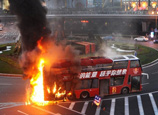
NEW YORK, July 9 (Xinhua) -- New York City Police Department (NYPD) and Brookhaven Lab begin to conduct an airflow study in the city's streets and subways Tuesday, to better understand the risks posed by airborne contaminants.
Researchers will disperse low concentrations of harmless gases known as perfluorocarbons at several subway and street-level locations in Manhattan for 30 minutes during the morning of three, non-consecutive days.
The NYPD and MTA (The Metropolitan Transportation Authority) worked closely together on planning and implementation of the study, which will include 21 subway lines and several dozen stations citywide, in addition to the street-level research, according to an earlier statement issued by NYPD.
The field study is designed to have zero impact on commuting and other public activity. Members of the public may notice clearly marked boxes containing the air sampling equipment secured in subway stations, on street light poles, and hand-carried by researchers.
The NYPD will use the data collected during the three days of research to optimize emergency response following an intentional or accidental release of hazardous materials.
"The NYPD works for the best but plans for the worst when it comes to potentially catastrophic attacks such as ones employing radiological contaminants or weaponized anthrax," said Police Commissioner Raymond W. Kelly.
"The NYPD, in partnership with the MTA, is responsible for keeping more than 5 million daily subway customers safe and secure. This study will bolster the NYPD's understanding of contaminant dispersion within the subway system as well as between the subway system and the street, thereby improving its ability to better protect both our customers and the city population at large," said MTA Acting Chairman Fernando Ferrer.
In addition to the study in Manhattan in 2005, previous airflow studies were conducted in subway systems in Boston, and Washington, D.C. , but none as extensive as the one planned for New York City in July.
While the study is focused on the airflow and dispersion of airborne contaminants resulting from the release of a CBR agent, the findings will also enable city agencies to better understand dispersion characteristics of other potential inhalational hazards, such as smoke or fumes from chemical spills.
The study is also expected to help police and other agencies decide where to best locate CBR detection equipment. Results from the study will help authorities refine evacuation or other responses in the event of an emergency.
















 Severe rainstorms batter SW China quake-hit regions | Pedestrians fall into river after bridge collapses
Severe rainstorms batter SW China quake-hit regions | Pedestrians fall into river after bridge collapses


![]()
